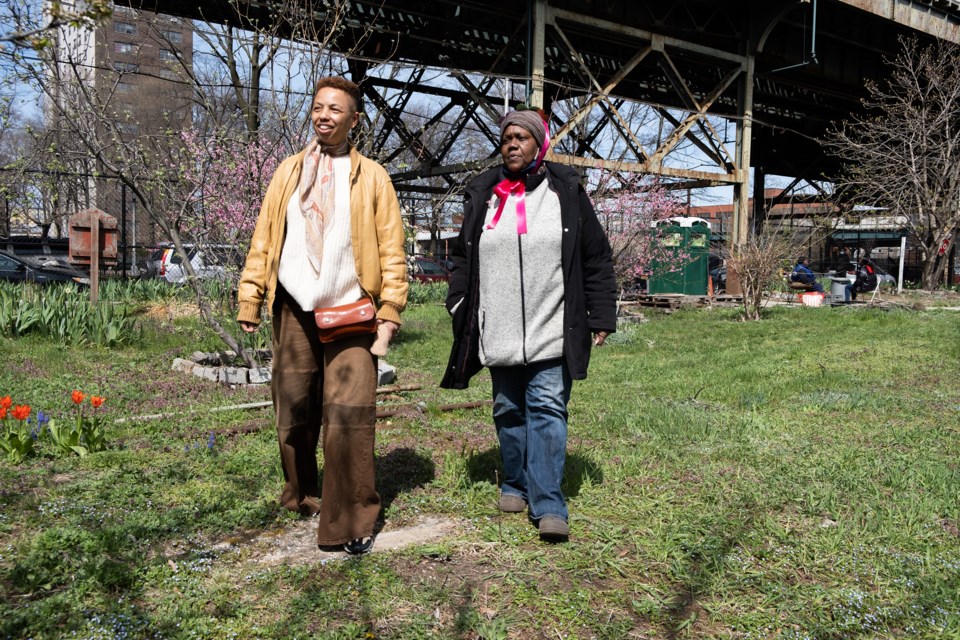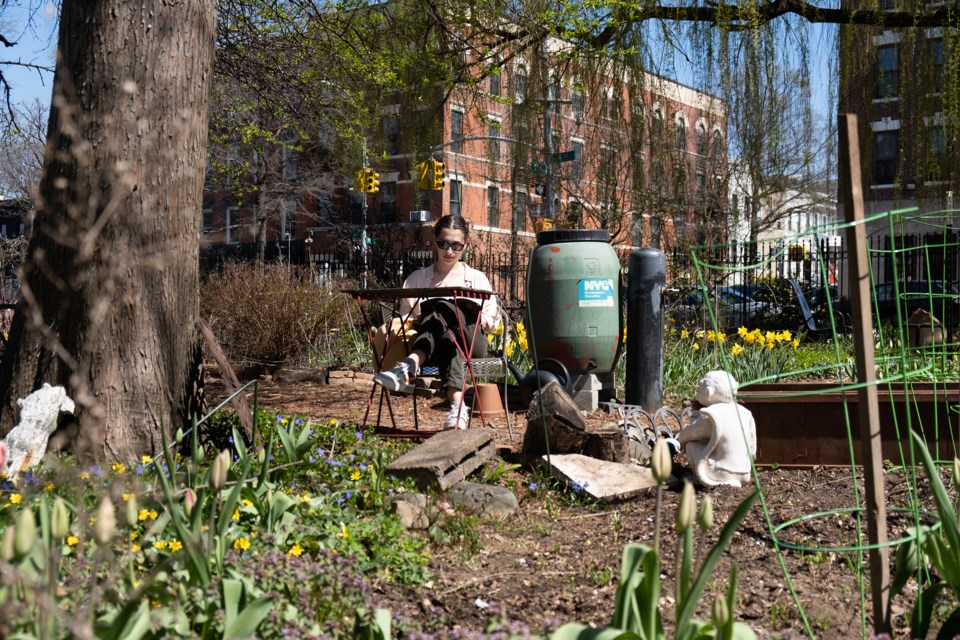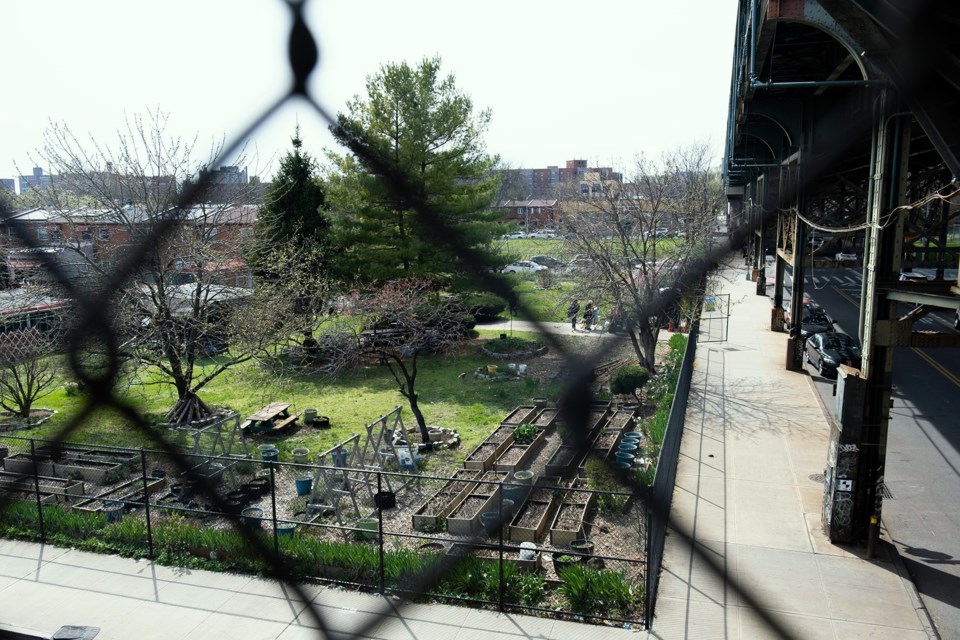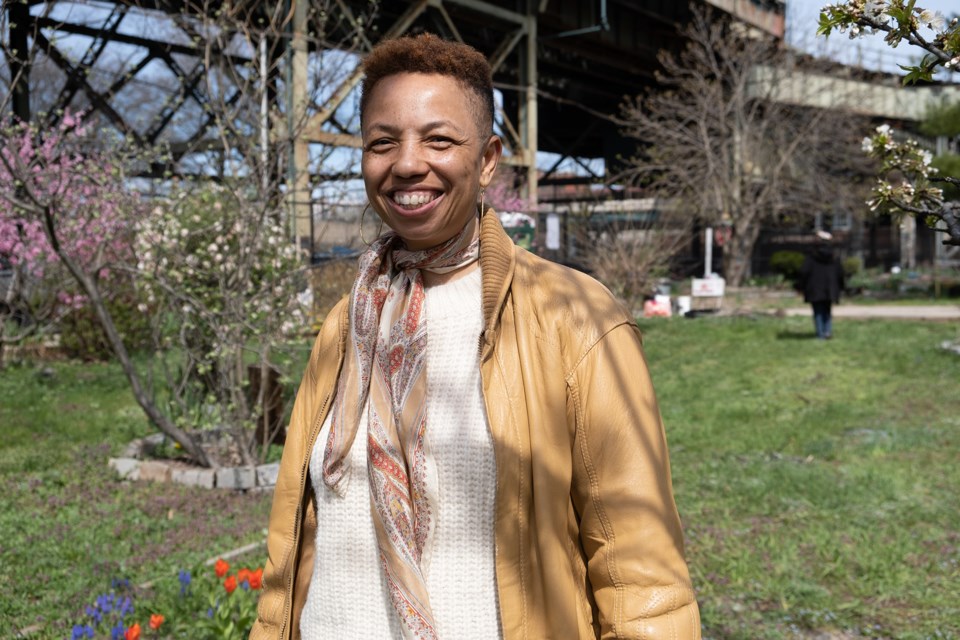In the shadow of the elevated L train, across from a lot full of lumber and railroad ties, the Powell Street Garden in Brownsville is a little piece of community-cultivated paradise.
On the Saturday before Easter, an array of soon-to-bloom fruit trees peppered the garden’s half-acre. Around its perimeter were tulips and raised beds to grow the veggies that will be sold at the on-site farmer’s market this summer.
The Isabahlia Ladies of Elegance Foundation was hosting an Easter celebration when Qiana Mickie, the new director of the Mayor’s Office of Urban Agriculture, strolled into the garden.
Last September, Mayor Eric Adams appointed Mickie to spearhead the administration’s efforts to support and expand community gardens and urban farms in the city. Brooklyn is home to nearly 300 community gardens, more than any other borough.
Brenda Duchene, who runs the Powell Street Garden, was already familiar with Mickie from her 10-plus years of work in food policy and equity.
“She’s not assuming [and] sitting behind a desk — she knows what it is that we’re doing,” Duchene said.

In the past, Mickie has endorsed “solidarity economies,” engaging farmers and gardeners and asking what support they need rather than delivering solutions from a vacuum. In the first six months on the job, she said she’s been doing just that.
“I needed to understand how I could go to different agencies and say ‘Here’s the great work you’ve done so far. … Here’s a way that you can infuse and advance urban agriculture and equity,’” she said. “I’m not going to get everybody on board with urban agriculture without it being a mix of vision and pragmatism.”
Mickie first became interested in healthy food and food equity when she became a mother. She realized how hard it was to access healthy food in Harlem, where she lived. She began volunteering with a group called Harlem for Change, which kick-started her interest in food policy. She eventually became the executive director of the nonprofit Just Food.
Mickie has been particularly focused on increasing healthy food access and agricultural leadership opportunities in communities of color. She has also worked internationally and serves on the coordination committee of the United Nations’ Civil Society Mechanism.
After leaving Just Food in 2020, she spent nearly three years as a consultant for food enterprises and cooperative start-ups.

Now, Mickie has a small staff in her new post, which includes a deputy director, though she can liaise with other agencies, such as NYC Parks GreenThumb and the Department of Education.
She expects to benefit from her nonprofit experience, working with tight budgets and broad visions.
“I think [Mayor Adams] appointed me because he knew I could get stuff done,” she said.
The Mayor has touted his previous investments in urban agriculture. As Brooklyn Borough President, Adams dedicated capital funding to vertical farming and hydroponics labs in Brooklyn schools.
“Urban agriculture is a growing industry in our city that has the potential to expand the supply of healthy and locally grown food, create jobs and make our city more resilient,” he said in the release announcing Mickie’s appointment. “[Mickie] will play an integral role in advancing my food and sustainability agenda.”
If the urban agriculture system in NYC is a tree, Mickie is working between the roots and the fruits of each gardener’s labor. While she can’t directly fund initiatives — like the pavilion the Powell Street Garden needs — she can co-write grants with other agencies, connect community gardeners with resources and advocate for their needs.
Space is the most valuable resource in NYC, and in Brooklyn, she said, “Something that really resonates with folks is innovative land use.”
“I don’t want people to feel urban agriculture has to be pitting folks that are most impacted against each other,” Mickie said. “I’ve been trying to identify ways that urban agriculture is more of a collaborative solution to existing community needs and struggles.”

One parcel of well-stewarded land can offer a lot to the surrounding community. On top of providing fresh produce to the neighborhood, the Powell Street Garden also mitigates stormwater for the housing complex behind it. The Isabahlia Foundation hosts educational opportunities there for students and has purposefully kept enough running space for children.
“In this community, a lot of kids don’t go no more than a block radius. They have never seen vegetables, how they grow; they’re just used to seeing them in the supermarket,” Duchene said. “This spot has really resonated with the schools to come in, because it’s a safe spot.”
Other concerns Mickie has heard from urban agriculture practitioners include climate resiliency, affordability and a desire for more clarity from city agencies. For example, on a city level, parks and gardens are lumped together, which Duchene said can make licensing confusing and scalability more difficult.
People have also said they want equipment to process food on-site to sell — sofrito or salsa, for example.
Like any gardener, Mickie will have to promote healthy growth by using the resources on hand. The people with their hands in the dirt will lead. But a little city support could be a welcome fertilizer.
“Brooklyn is a great example,” she said. “We have so many Black, brown and other folks of color that are land stewards who have been doing this for years — decades, even. And we have some younger folks coming in who are excited-- desperate even-- to be land stewards. But they don’t just want to do it for fun; they don’t want to do it just for that one apple or that one tomato.
More and more [people say], ‘We need to get beyond a half-acre; we need to get beyond our plot. How do we scale that?’ Well, you can’t scale that without infrastructure.”



.png;w=120;h=80;mode=crop)
